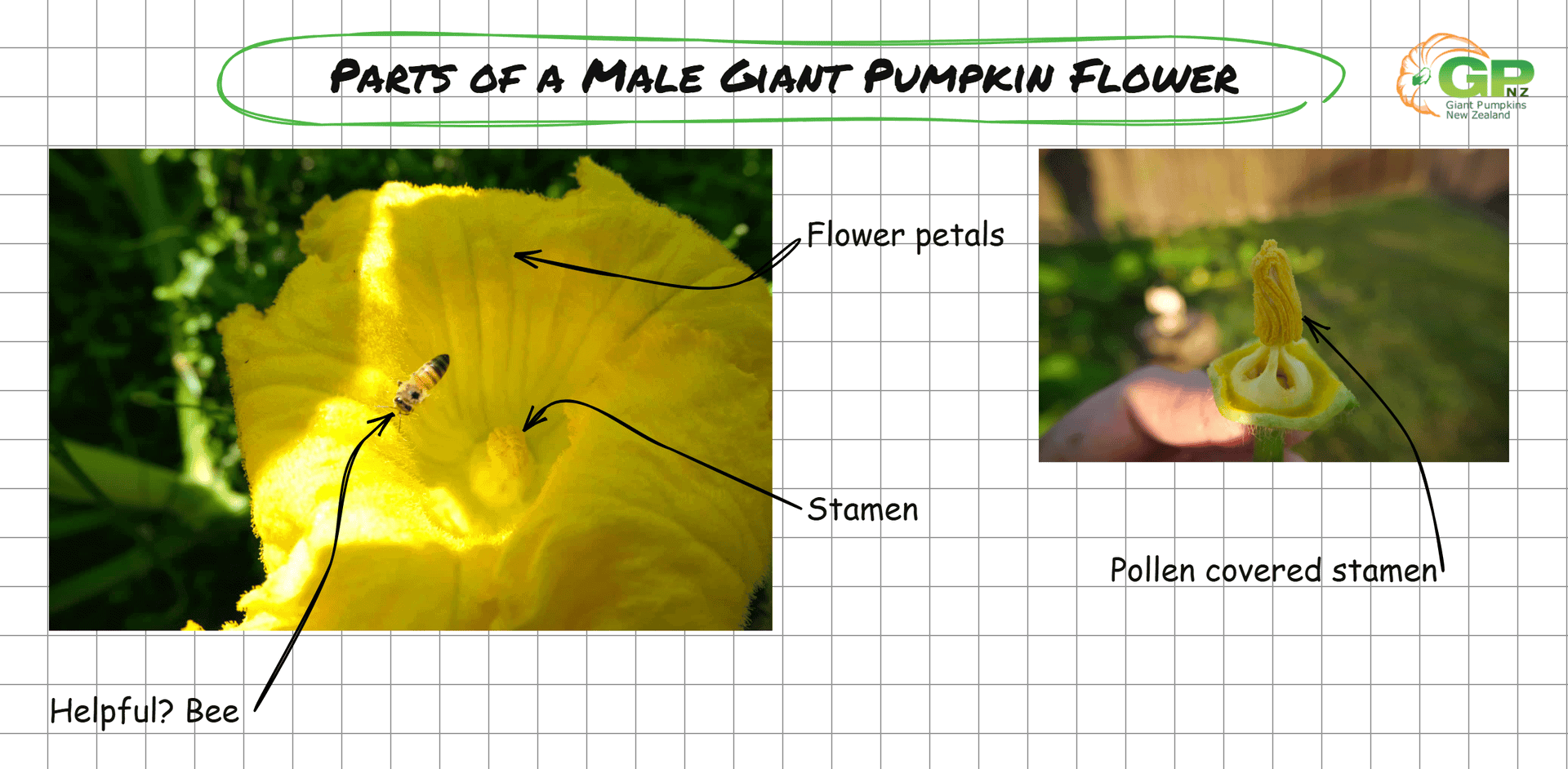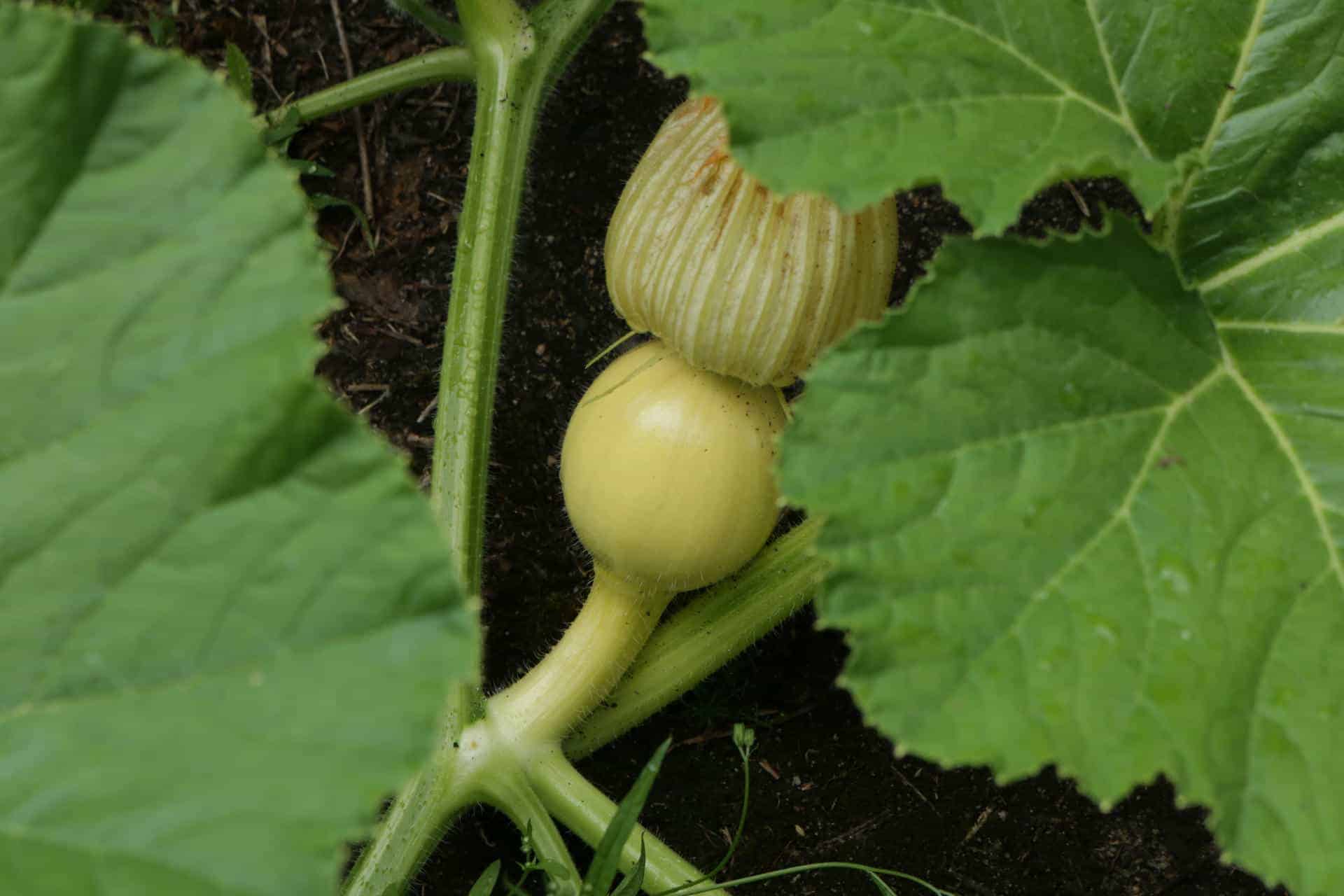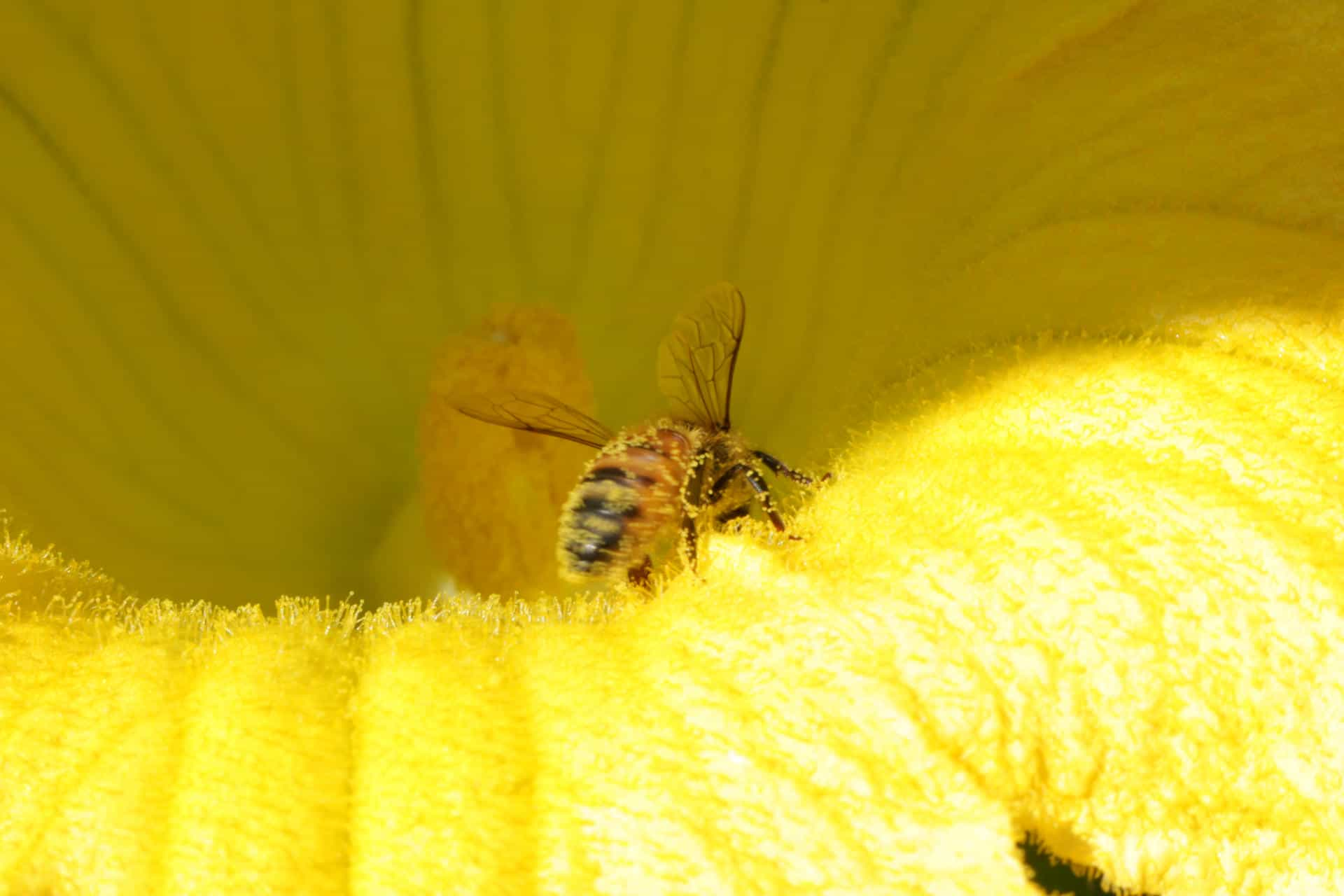When it comes to growing giant pumpkins you have a couple of decisions to make when it comes to pollinating the flowers to get your pumpkin growing.
Before we get to that lets discuss the flowers and their parts.
Giant Pumpkin – Male Flowers
Male flowers on a giant pumpkin plant will be the first flowers to appear and are usually appearing 7-10 days before the first female flowers. At every leaf axil (where the leaf is connected to the vine) a male flower will appear. These male flowers will be very upright.
A male giant pumpkin flower looks like a regular flower, there is no bulb looking part on the base. The make flower has the pollen the female flower needs.
Several male flowers might be of no use to you and that’s OK. Patience is key.
The inside of a male flower consists of:
- Flower
- Stamen
- Pollen

Giant Pumpkin – Female Flowers
The most notable difference with this flower compared to the male is the small pumpkin at the base of the flower. This small bulb will grow into a pumpkin once the female plant has been pollinated. The female flowers will appear after the first male flowers, the quantity of them will be less and they will appear less upright.
Inside the flower is the female blossom, this is what will receive the pollen from the male flower. Not all female flowers are created equally.
The female flower consists of:
- Flower
- Stigma
- Unpollinated pumpkin at base

Things to Decide on When Pollinating
When it comes to pollination and more importantly hand pollination you have to decide on what female flowers you want to pollinate.
- Where is the female flower located on the vine?
- Does the blossom part of the female plant look OK?
Flower position on the vine
Firstly it doesn’t really matter where the males are located on the vine. When they are ready you’ll be cutting them off to pollinate your female flower.
For the females you need to put some thought on where they are. This is where the pumpkin will hopefully grow if germination goes well.
For a lot of growers having the pumpkin growing on the main vine is important. This gives the pumpkin the best source of nutrients, a strong connection to the vine. Setting far out on the main vine is also common practice. This can vary of course depending on just how big your plant is at time of pollination.
Really big pumpkins have also been grown on side vines.
Because we can’t decide or influence where the female flowers will appear on the vine, we sometimes have to go with what we get and adapt.
Remember even if you have the best female flower picked, pollination may not occur or the pumpkin may abort early. Having other options is key. The key is to get the pumpkin to the size of a basketball before deciding what to cull.
How does the Blossom Look?
When looking into the inside of the female flower you will see the stigma, growers will often call these either segments or lobes. These are what need to be pollinated by the pollen found in the male flowers.
They also become the blossom end of the giant pumpkin.
There are usually 5 lobes or segments found in the female flower. This can vary but 5 is more common. Making sure these segments look well formed and uniform when compared together is important.
Segments that are deformed or not a uniform size or even contain what looks like seeds could cause a weak point once the pumpkin ha grown. Blossom end splits are common and can sometimes be traced back to a poorly formed blossom.
IMAGE HERE
How Many to Pollinate?
I would suggest around 3 female flowers would be a good number to aim for minimum.
Traditionally growers would cull all but 1 pumpkin once it reaches basketball sized. Putting everything into that one pumpkin and trying to get it to the scales.
Over the years some growers have grown multiple pumpkins on the one plant. Growers have different opinions on this method, with some stating the plant can support all the pumpkins. This might be an option if you need multiple pumpkins and only have the one plant.
Starting with multiples give you the best options later on and the best chance if something goes wrong.
Giant Pumpkin Hand Pollination (controlled / closed)
Hand pollinating a giant pumpkin which can sometimes be called “controlled” and is important when growing giant pumpkins. The main reason it is important is that it protects the genetics. The flowers you want pollinated get pollinated exactly when you need them to be.
Hand pollinating is really the best way to pollinate your giant pumpkin and it’s easy to do.
Identify and Plan
To hand pollinate you first need to identify both the male and female flowers you want to use. It might pay to mark them in someway the day before. Tape, sticks in the ground etc.
Male flowers and the pollen contained within them will last longer and be more viable than the female flowers. Watch your male flowers over time and you will get used to seeing when when they are close to having the flower open.

Keep the Flowers Closed
You’ll need something to help keep them closed to stop bees swooping in and taking the pollen you need.
Small clips, rubber bands, bags or disposable cups are all things that can work. Don’t worry too much about damaging the flower petals, you just want to keep it closed until it is ready.
Female flowers will also need to be closed off ahead of when they are ready. This prevents any unwanted pollen being delivered to the stigma. Preventing cross pollination is important when protecting the genetics.
Female flowers have a much shorter window of being viable than the male flowers. They will open early in the morning and be ready to receive the pollen from the male flower.
Day of Pollination
When the female flower is ready, get your male flower either from the same plant if self pollinating, or from a different plant if crossing.
Peel off all the flowers and hold the stem, using the pollen covered stamen like a paint brush, rub it over the stigma and pollinate the female flower. Get good coverage of the stigma.
Once as much pollen as possible has been applied. Make sure to close up the female flower to prevent any other pollen being deposited by bees.
Follow this process for all the female flowers you want to pollinate. It is a good idea to do this to as many female flowers as you can on your plant. It can be helpful to note when each flower was pollinated and by what.
Pinch off Unwanted Female Pumpkins
The plant will continue to produce female flowers and at some point there will be more than you need. Pinch these small flowers off to help the plant conserve energy and put it into the freshly pollinated ones.
Giant Pumpkin Open Pollination
Open pollination is when you let nature do it’s own thing. Bees will germinate your female giant pumpkin flowers.
As mentioned previously this can be problematic as you won’t know where the pollen has some from.

Note: The pollination of the giant pumpkin doesn’t effect the pumpkin that will grow now. It will effect the seeds from this pumpkin. So any problems or crosses that have undesirable consequences won’t be fully known until the seeds have been grown once harvested from this pumpkin.
This is why controlling the pollination of giant pumpkins is important. Especially when it comes to genetics and knowing what has been grown.
Self and Cross Pollination
Giant pumpkin plants are one of the easier plants to pollinate. The pollen itself can be seen with the naked eye. They also have the ability to be pollinated by other giant pumpkins or be pollinated by themselves.
NOTE: Not only can giant pumpkins be pollinated by other giant pumpkins they can also be pollinated by other members of the pumpkin family. Getting crosses of other things can cause the offspring – the seeds you get from this pumpkin to be less than ideal.
What do the Genetics Influence?
The genetics from the male plant crossed with the female plant dictate what the pumpkin grown from the seeds within this pumpkin will get.
The germination process will not influence the pumpkin you are growing right now. That was decided the previous season when whatever was crossed grew the pumpkin your seeds came out of.
This is why it is important to keep the genetics known if you want the best pumpkins. It helps a lot when sharing seeds as well. Keeping detailed notes of your pumpkins is beneficial.

i have 3 Big (Open) Female Flowers, but the males are tiny and closed (they look like the top picture)
is this the norm?
Hiya, yes it can be the norm, and you will find that some of the female flowers can go to waste while waiting for the male ones to open.